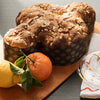

Like Panettone – on which it is based – Colomba hails from Milan in northern Italy. It was here, in the hi-tech bakeries that arose during the interwar years, that this wonderful dove-shaped cake was first developed.
What is the origin of Colomba cake?
Colomba di Pasqua (to give it its full name, which translates as 'dove of Easter') was created in the 1930s by Angelo Motta. On returning from the Great War, this Milanese baker set about making the highest quality baked goods. Using new technologies, he perfected many techniques. It was his innovations with Panettone – specifically its extra rising stage and complex method of upside-down cooling to preserve its glorious domed top – that helped popularise this festive treat.
What is the story of Colomba?
With a large new bakery on the outskirts of Milan, Angelo sought to create a new festive treat that would match the success of Panettone and Pandoro – cakes that required skills and machinery that just wasn't available to domestic bakers. Working closely with Motta's advertising director, Dino Villani, they developed a mould shaped like a dove for Colomba di Pasqua – creating an iconic, symbolic, and utterly unique Italian Easter gift.
What is Colomba Cake?
If you've ever tried Panettone, Colomba cake will be somewhat familiar. It is an enriched bread – a yeasted sweet dough to which eggs and butter are added. After being left to rise for many hours, the dough is shaped into a flying dove, topped with almond paste, pearl sugar and almonds, then baked to perfection.
Similar to Panettone, Colomba begins with a sourdough starter (aka pasta madre or 'mother dough'). This goes through a long raising process to create the cake's airy structure and full flavour. Once the dough has gone through its initial rise, it is enriched with butter, sugar and eggs – to make the finished bread even softer and more luxurious. It is then studded with candied orange giving Colomba cake its lovely citrussy flavour.
What shape is Italian easter cake?
After being shaped into its iconic dove mould, the Colomba is given another long slow rise. This allows the yeast to develop the dough's moist and chewy texture. Lastly, before being baked, the top of each Colomba is decorated with almond paste, crunchy sugar and whole nuts. As the dough rises in the oven, the almond paste cracks and the almonds and sugar create a distinctive feather-like appearance.
What does Colomba cake taste like?
Anyone who's celebrated Easter in Italy will know that Colomba cake is one of the highlights of the festivities. What better way to mark the end of Lent than with a slice of golden Colomba, suffused with aromatic candied peel and crunchy roasted almonds?
As with Panettone, citrussy Colomba cake is loved not just for its flavour, but its texture. This is where the genius of the enriched dough shines. You just can't get the same structure with sponge cake. And by using a sourdough 'mother' as the base of Colomba, the extra depth of flavour that develops through the long rise makes it such a treat. It's the perfect backnote to the candied fruit, honey and vanilla that scents the dough.
Colomba di Pasqua is hugely versatile. Enjoy a slice with your morning cappuccino – or glass of sparkling Moscato wine! You can also serve it as a dessert, topped with fresh berries and chocolate sauce, frothy zabaglione, or just a dollop of whipped cream. You can even use it as the base for a very fancy tiramisu or bread and butter pudding!
Is Colomba the same as Panettone?
While they are similar, Panettone and Colomba cake aren't the same. They both start out as sweet yeasted breads enriched with eggs and butter, but once the doughs are made, that's where the two cakes diverge.
Colomba di Pasqua is liberally enriched with candied orange peel, whereas Panettone tends to have raisins added as well as peel, making it sweeter overall. Once baked, Panettone is also turned upside down to cool. This prevents the domed top from sinking back down and as such, Panettone tends to be more 'fluffy' than Colomba.
But apart from the obvious shape differences, the real beauty of Colomba is the almond and sugar crust on the top, which adds crunch to the overall texture, as well as a sweet nuttiness. The contrast with the soft dough and chewy candied peel is just sensational.
As with Panettone, there are now many variations of Colomba di Pasqua. There are chocolate and pistachio versions, even vegan and gluten free ones. But whichever type of Colomba cake you choose, just know that you'll be enjoying one of the world's finest Easter cakes in the spiritual company of a country who put the love of food and family above all else. And that's always something worth celebrating!
See our full range of Colomba cakes



